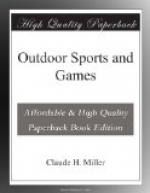The subject of snakes is one in which there is more misinformation than any other common thing. There are only three venomous kinds of snakes in America. They are the rattlesnake, copperhead and moccasin. All of them can be distinguished by a deep pit behind the eye, which gives them the name of “pit vipers.” The general impression that puff adders, pilots, green snakes or water snakes are poisonous is absolutely wrong, and as for hoop snakes and the snake with a sting in his tail that all boys have heard about, they are absolutely fairy tales like “Jack and the Bean Stalk” or “Alice in Wonderland.” We have all heard about black snakes eight or ten feet long that will chase you and wind themselves around your neck, but of the many hundreds of black snakes that a well known naturalist has seen he states that he never saw one that did not do its best to escape if given half a chance. Why so much misinformation about snakes exists is a mystery.
Nature study has recently been introduced into schools and it is a very excellent way to have the interesting things pointed out to us until our eyes are trained to see for ourselves. The usual methods of nature study may be roughly divided into, 1. Keeping pets. 2. Bird study. 3. Insect study. 4. Systematic study of flowers and plants. 5. Wild animal life. The basis of nature study consists in making collections. A collection that we have made for ourselves of moths or flowers, for instance, is far more interesting than a stamp or coin collection where we buy our specimens. If we go afield and collect for ourselves, the cost is practically nothing and we have the benefit of being in the air and sunshine.
One kind of collecting is absolutely wrong—that of birds’ eggs, nests or even the birds themselves. Our little feathered songsters are too few now and most states have very severe penalties for killing or molesting them. A nature student must not be a lawbreaker.
The outfit for a butterfly or moth collection is very simple and inexpensive. We shall need an insect net to capture our specimens. This can be made at home from a piece of stiff wire bent into the shape of a flattened circle about a foot across. Fasten the ring securely to a broom handle and make a cheesecloth net the same diameter as the ring and about two feet deep.
[Illustration: The cyanide bottle]
It is very cruel to run a pin through insects and to allow them slowly to torture to death. An insect killer that is generally used is called “the cyanide bottle.” Its principle ingredient, cyanide of potassium is a harmless looking white powder but it is the most deadly poison in the world. Unless a boy or girl knows fully its terrible danger, they should never touch it or even breathe its fumes. One of your parents or the druggist should prepare the cyanide bottle for you and as long as you do not look into the bottle to watch the struggles of a dying bug or in any way get any of the contents of the bottle on your fingers, you are safe.




